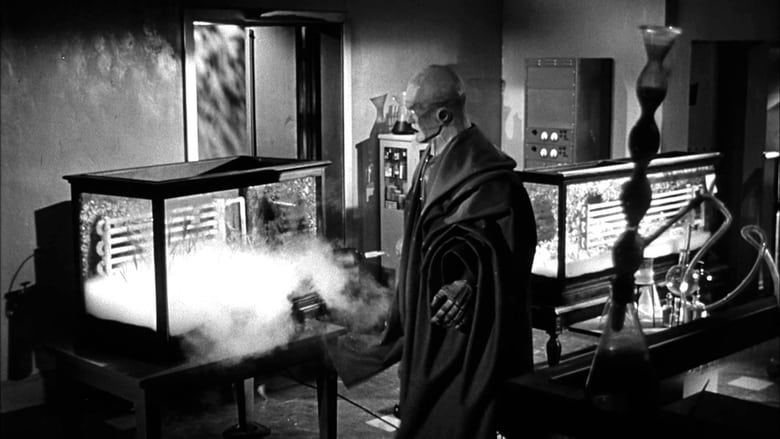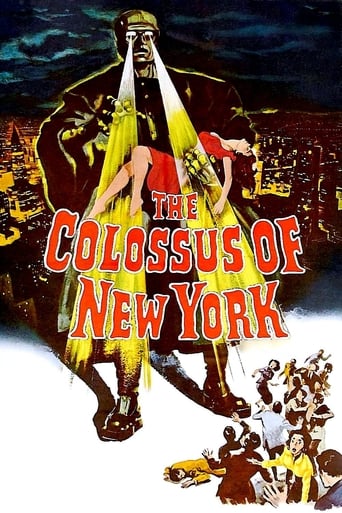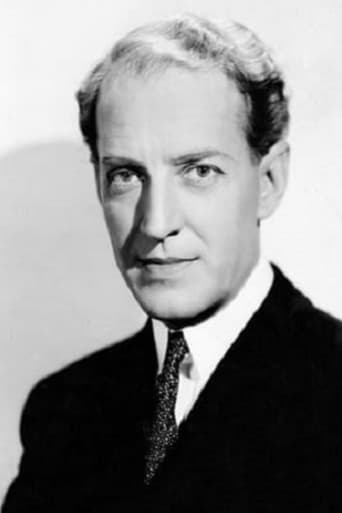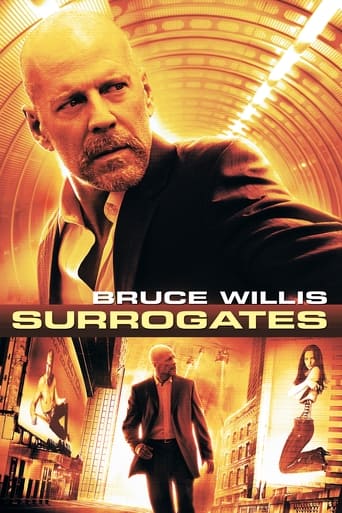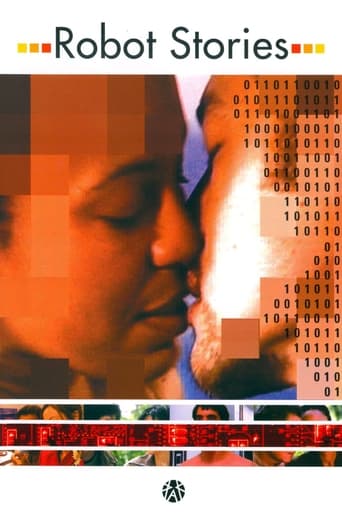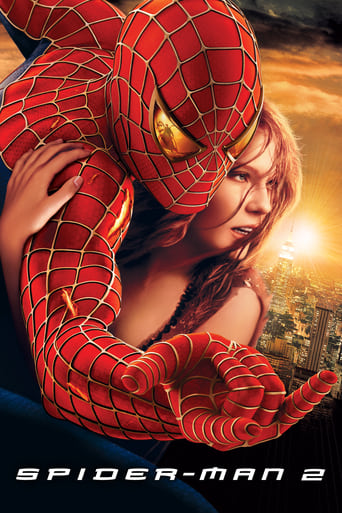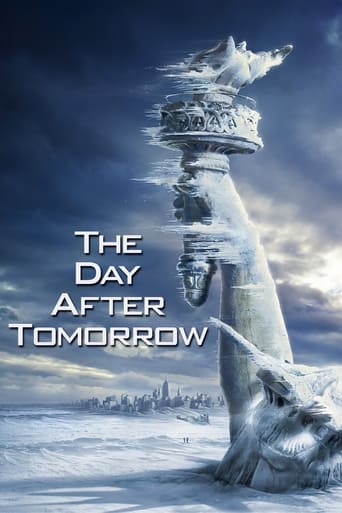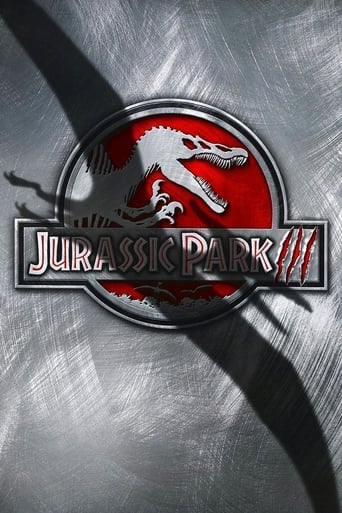The Colossus of New York (1958)
A brilliant surgeon encases his dead son's brain in a large robot body, with unintended results...
Watch Trailer
Free Trial Channels
Cast


Similar titles
Reviews
Excellent, a Must See
It's fun, it's light, [but] it has a hard time when its tries to get heavy.
Exactly the movie you think it is, but not the movie you want it to be.
Through painfully honest and emotional moments, the movie becomes irresistibly relatable
There have been a lot of stories about brains being separated from their owners' bodies and kept alive for one reason or another. Usually the brain is that of a genius, as in John Hersey's 1960 novel. Sometimes it's an evil brain or a mad brain. Here it belongs to a genius, run over by a truck while in his prime.His equally brilliant brother (John Barragray) is an expert on automation. That's a fancy word for "robots." The father (Otto Krueger) is a renowned neurosurgeon. When you put the three of them together -- the brain of a brilliant young scientist, his automating brother, and his neurosurgeon father, you merely put Tab A into Slot B, and you get a robot with an exceptional brain.The performers are okay. Alas, Otto Krueger has aged since he was the suave villain in Hitchock's "Sabotage," not so much in his appearance as in his speech. It sounds as if his dentures were sliding around. Barragray, the automating brother, has a voice made for radio but his looks fit the template of the role. Robert Hutton as a scientist who is a friend of the family is painful. The poor guy. Mala Powers is the wife of the lonesome brain, the brain that's asleep now in its fancy aquarium. She is a knockout in the most wholesome sort of way. She looks like a particularly buffed version of the girl next door, if the girl next door looked like Mala Powers. A serious actress too, a committed follower of Michael Chekov.Anyway, the resulting robot resembles a human being as painted by some futurist nut. It has a body like Frankenstein's monster and a simulacrum of a barely human metal head and face. I don't know why the faces of these robots have to look so threatening. A normal human mask can be pretty scary. "Les Yeux Sans Visage" -- "Eyes Without A Face" -- are pretty eerie. A Guy Fawkes mask is unsettling.Anyway, this robot, although a giant, is no Frankenstein's monster. With its supports removed, it stumbles to a mirror, gets a look at itself, lets out a shriek, and flops on the floor. Any one of us who has looked into a bathroom mirror the morning after a particularly troubled night can immediately empathize. But if the robot is ugly, it's also clairvoyant and predicts a collision at sea involving a passenger ship called the Viking. The film was released in 1958, probably written in 1957. Barragray is stunned when the TV news reports the collision, showing the listing Italian liner Andrea Doria, which was sunk by collision the year before. Actresses Betsy Drake and Ruth Roman were among the survivors. The incident was still fresh in the public's mind.A year later and the wretched thing is no longer speaking in drawn-out electronic gargles but is fully articulate. And, like other monsters before him -- the invisible man, Frankenstein's creation -- he goes round the bend, driven by his ego. But instead of running for president, he paralyzes his surgeon father and bursts through the laboratory door to take a walk outside. Discovering that his brother is in love with his wife (or widow) the monster commits fratricide and then goes irretrievably mad. The ending is more or less arbitrary and not worth much attention.Sometimes these Grade B monster movies can be diverting. I found this one to be more irritating than anything else.
i was born in 1957 and have loved horror movies since i was a kid. Somehow, this movie never crossed my path in my childhood years. I never heard of or saw this movie until 1980. We had just gotten cable TV and this movie was shown in a horror movie marathon, including Earth vs. The Flying Saucers and The Day the Earth Stood Still. I thought this movie was above average but never considered it "great," however, over the years, it's kind of grown on me. I've always liked Ross Martin, who is the star of this movie. There are many movies i would consider better but for some reason, i still like watching this movie. I ended up buying the blu-ray version.
Reviewers appear to be about evenly divided on this film. Half are enraptured by "The Colossus of New York", and half think it's laughably bad. I tend to be in the middle somewhere. I think the movie is a slightly above average 1950s sci-fi/horror flick with a very good cast and some interesting twists. However, I've never thought the film represented some sort of special viewing experience.Ross Martin plays a scholar/humanitarian/all around good guy who is killed off in an unfortunate accident early in the film. His father (Otto Kruger, in an extremely pompous performance) implants Martin's brain in a huge Frankenstein-ish robot (played by Ed Wolff).Naturally, the robot doesn't just sit around smoking cigarettes and watching TV--he predictably goes berserk, wreaking havoc on Martin's enemies and, in a somewhat mawkish plot twist, befriending an innocent little boy. After smashing all kinds of things, the robot commits suicide with the help of his little schoolboy friend, dying at the UN building in New York.The pluses are a good cast, fine piano score, and very good photography on a limited budget. The minuses are the predictable storyline and the awkward relationship between the homicidal robot and a little boy. Worth a look, but not a classic in my opinion.
A still from this film, depicting the titular robot and a little boy, had adorned the cover of that Sci-Fi issue of “The Movie” periodical which I mentioned in my review of ATTACK OF THE 50 FOOT WOMAN (1958) – and I’d always been interested in it for this reason (considering that it’s a title which is rarely discussed). Despite being produced by a major Hollywood studio, Paramount, the film is definitely a ‘B’ genre effort – made to cash-in on the sci-fi craze of the Cold War era. The makers clearly relied on such classic prototypes as THE GOLEM (1920), METROPOLIS (1927) and FRANKENSTEIN (1931) for inspiration – but, being somewhat underwritten, the plot doesn’t quite supply the necessary impetus to elicit favorable comparison with them! Mind you, it’s fairly intriguing during the first half (surprisingly written by FATHER BROWN [1954]’s screenwriter Thelma Schnee!) and bolstered throughout by reliable Otto Kruger’s mad scientist characterization. Besides, the design of the robot itself (fitted with the re-activated brain of Kruger’s son, a humanitarian-cum-genius prematurely killed in a road accident) is interesting and actually quite eerie…though bestowed with curiously short arms! However, the latter doesn’t have that much to do since it’s confined for the most part to Kruger’s lab! Eventually breaking free of its creator/father’s control, the robot emerges into the open and befriends his own son (who’s unaware of the machine’s true ‘identity’). Inevitably, the human feelings once inherent in its brain gradually get lost within the metallic ‘armor’ – and the scientist even kills his own elder brother (for attempting to steal his wife’s affection…though she’s also pursued by his former best friend, who’s allowed to get away with it!). Finally, having gone berserk, the robot breaks into the United Nations building (the ‘monster’ during the sci-fi heyday always seemed to vent its fury at some point on such big-city landmarks), where it’s destroyed – or, more precisely, shut off – via a convenient lever lodged in its structure by the boy himself! The film, as I said, doesn’t quite make it into the genre’s top-rank – but, running a terse 70 minutes, emerges nonetheless to be a generally entertaining entry (and not an unintelligent one, either). That said, it’s somewhat cheapened by Van Cleave’s funereal score (which is more akin to the slapdash accompaniment one is prone to find in Public Domain editions of Silent films!). Besides, there are a number of illogicalities in the narrative which tend to stick out like a sore thumb: for instance, the robot is often seen traveling via water – but wouldn’t contact with this element cause a short circuit to begin with?; despite Kruger’s audacious claim that his son’s genius is on the same level of such world-renowned luminaries as Napoleon, Macchiavelli and Michelangelo, the young doctor’s major claim to fame seems to be merely that he had invented a way in which to fabricate food products more quickly!!; the climax is marred by a blatant continuity goof – a girl is seen on the ground in one shot, up on her feet the next and, then, once again on the ground to be pulverized by the robot’s laser beam!; as soon as the creature is gotten rid of, it’s business as usual for the folk at the United Nations – with no thought given to the many who had just lost their lives!; a similar nonchalant reaction is allotted to Kruger, who admits his responsibility for the tragic events – and, yet, isn’t held to account for his irresponsibility!

